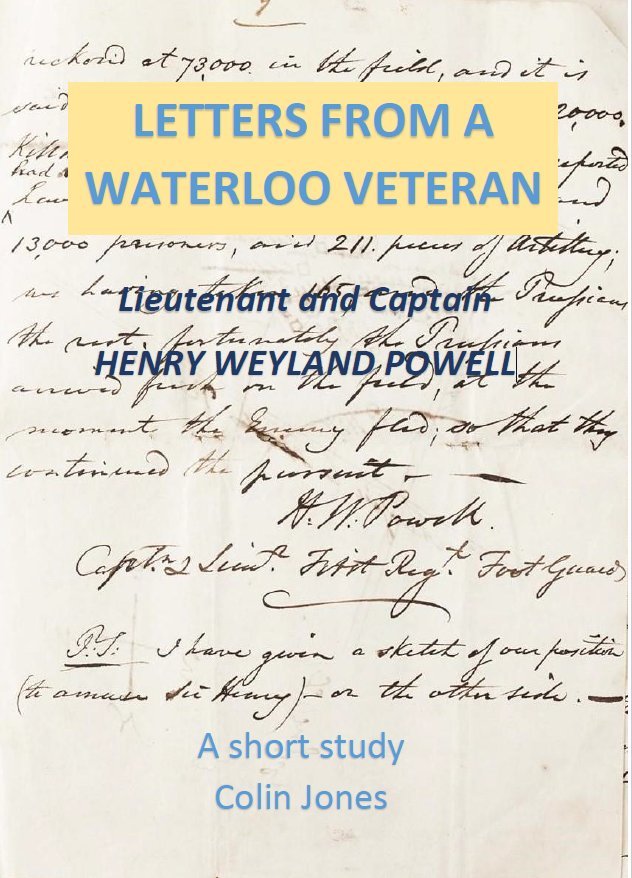
Introduction
Included here are three letters written by 2nd
Lieutenant and Captain Henry Weyland Powell. The first two have
previously been published in response to Captain William Siborne’s
circular letter in the 1830’s, requesting information from the
surviving Waterloo officers regarding the construction of a model of
the field of battle, asking recipients details and any circumstances
in which they were placed on that memorable occasion of the 18th
June 1815.
The third letter was written by the author two days
following the battle and to my knowledge, has never previously been
in print. The first letter describes Henry’s participation at the
battle of Quatre Bras and the march to the field of Waterloo, the
second describes the climax of the conflict on the 18th. These first
two letters were taken from the author’s journal which was written
sometime after the event where he had time to make corrections and
consult other sources before putting pen to paper. Although all
three letters are significant in their own right, the third letter
was written two days after the battle and exemplifies the excitement
and confusion of the battle with little time for reflection and
therefore falls into the category of a true primary source of which
there can be but few. Particularly with the addition of Henry’s
sketch, attached to the end of the letter, drawn from his personal
perspective. The letter was auctioned by Lyon & Turnbill on 24th
June 2015 during the bicentennial year and was sold for £3,750.
I
have decided to include the previously published letters in order to
attain a more complete picture of his circumstances during the time
the third letter was written, and to further understand his role in
the culmination of the campaign. Particularly when Henry describes
the final attack of the Imperial Garde which has lain in controversy
with historians for many years.
(1)
The author of the letters was educated at Trinity college, Cambridge
and enlisted in the army as Ensign on 7th April 1808. He served in
the ill-fated Walcheren expedition, the Peninsular war July 1811 –
May 1813, was present at Cadiz and Seville and was commissioned into
the 1st Regiment of Foot Guards on 22nd January 1813. During the
hundred days he served in Lieutentant Colonel Cooke’s 1st Company of
the 2nd battalion Foot Guards at Quatre Bras and Waterloo. His was
the son of Thomas and Clarissa Powell and married Eliza Buckworth in
1816. They had two sons Henry Buckworth and William Martin and two
daughters Clarissa and Mary Catherine. He left the service in 1821
and in 1828 purchased the Foxlease estate in Lyndhurst, New Forest,
Hampshire.
At Waterloo his battalion was in Maj-Gen. P. Maitland’s
1st brigade who were stationed on the main ridge and took part in
repelling the attack of Napoleon’s Imperial Garde. Wellington
apparently addressed them with the famous lines: ‘Now Maitland,
now’s your time.’ Although, as will be seen in in Henry’s 2nd
letter, he attributes a similar phrase to that spoken by Lord
Saltoun.
Henry’s name is listed in the Waterloo Medal roll and
appears in Dalton’s Waterloo Roll Call incorrectly named Harry. He
missed out on the General Service Medal for his service during the
Peninsular war, passing away eight years prior to the issuing of the
medal in 1848. Both Henry, who died on 17th July 1840, and his
mother, who passed seven years later, were initially interred in
Fulham, Middlesex but both remains were removed to St Michael and
all Angels church in Lyndhurst, New Forest in 1865, where they
remain today.
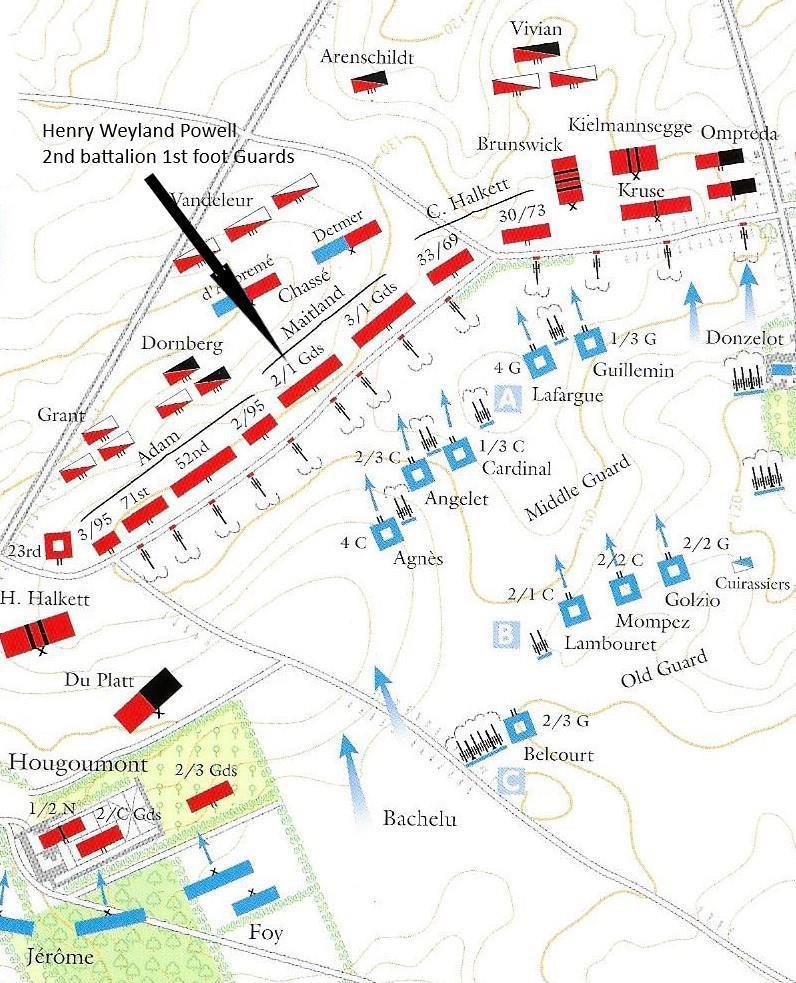
Battle of Waterloo 18th June 1815 Around 7.30pm
1st Letter
Siborne Letters No.108. Quatre Bras.
From Foxlease, Lyndhurst. No Date.
June15th, 1815.
Two o’clock PM. Dragoon brought word that the French were crossing
the frontier, and to hold the Brigade in readiness to move. Eight
o’clock – A second dragoon arrived with intelligence that the
Prussians had been forced across the Sambre. Orders were issued for
the right wing of the 3rd Battalion to remain at Hove with the left
wing, having been moved to that village on the first order. I find
that I have forgotten to state that the 2nd Battalion were quartered
in the town of Enghien, and that the right wing of the 3rd Battalion
was at the village of Mark, and the left wing at the village of
Hove.
June 16th,
half-past one a.m. drums beat to arms, the Battalion and baggage
ready to move at two. At three the order came for the Brigade to
assemble at Hove. Heavy stores and Hospital ordered to Brussels. At
four, the order was given to move to our left, over the position of
Steenkirke, in the direction of Braine-le-Comte, where it arrived
about nine o’clock, having been joined by the second Brigade (2nd
Battalion Coldstreams and 2nd Battalion 3rd regiment) on the march.
We halted on the eastern side, having had great difficulty in
getting through the town in consequence of the numberless wagons and
baggage confusedly huddled together in the street.
About Twelve, general Cooke returned from a reconnaissance to the
southward, and (as said at the time) on his own judgment ordered the
Division to move to the left towards Nivelles. The heat was
excessive, and the men suffered much from the weight of their packs,
at about three p.m. the Division arrived within half a mile of
Nivelles, and took up a position looking over the town, supposing
our day’s work was done. We were, however, scarcely halted, and the
men disencumbered of their loads, when an Aide-de-camp brought the
order to advance immediately.
The Division were under arms in a minute, and started double quick
down the hill into Nivelles, supposing that the Enemy were entering
it at the other side, for firing had by this time become very heavy,
and apparently very close. We continued our march through the town
to Hautain-le-Val, where we halted to collect stragglers and to let
the Artillery pass to the head of the Column.
We then continued along the chaussee from Nivelles to Namur.
On the march the order was given to untie ten rounds ammunition and
to see the flints in order, then for the officers to join their
Companies and fix the bayonets. On the road we met many wounded, and
Major Jessop, of the 44th (Q.M.G. department) shot through the foot;
who urged us to get on as the action was going on badly.
As we advanced the wounded became more and more [numerous] along the
sides of the road. At nearly five p.m. we arrived at the head of a
wood that abutted on the chaussee to the right, when the
Light Infantry of the Brigade, under Lord Saltoun, were ordered into
it, and as the head of the 2nd Battalion 1st regiment came up, they
were also ordered in, two Companies at a time, to support and assist
the Light Infantry till the whole Battalion were in the wood.
This wood was called the Bois de Bossu, and might on an average be
about three-fourths of a mile long and three hundred yards broad. A
small stream ran across it. On the left side and close to the edge
was a hollow way running along the eastern side. The men gave a
cheer, and rushing in drove everything before them to the end of the
wood, but the thickness of the underwood soon upset all order, and
the French Artillery made the place so hot that it was thought
advisable to draw back to the stream, which was rather more out of
range. A great many men were killed and wounded by the heads of the
trees falling on them as cut off by cannon shot.
The order was then given to form line outside the wood to our left.
By this time our 3rd Battalion had come down the wood, and together
we formed with our right on the wood and our left towards the
chaussee from Brussels to Charleroi.
As all order had been lost passing through the wood, the men formed
up as they came out and extended the line into the standing corn. A
great many men of other regiments who had been engaged before we
arrived, very gallantly left the wood and fell in with our men. The
line again advanced, but never could get beyond a certain point.
Here we stood firing at the Enemy in front who deployed most
steadily under our fire, whilst the French Cavalry kept moving about
for an opportunity of charging us.
During our advance a battalion of Black Brunswickers (so called from
their black uniform, being [in] mourning, as we heard, for their
Duke killed at Jena, and from their Teutonic custom of blacking
their faces) had followed in the open field along the outside of the
wood, and were manoeuvring to form on our left when the French
cavalry charged our left and drove us all into the wood on the
right. The hollow way now covered us from the Cavalry, and from it
the men threw in so destructive a fire as to nearly annihilate them,
whilst the Brunswickers (whose front became uncovered by our retreat
into the wood) formed square beautifully, and did their part most
effectively in their destruction. Many men and horses were taken who
fled for shelter into the wood, which supplied our mounted (or
rather dismounted) officers with fresh horses. In this charge lord
Hay was supposed killed.
The tiraillerie continued during the daylight, and General
Maitland took the 3rd Battalion to the end of the wood which the
enemy now no longer disputed,
and having thrown out pickets for the night, directed the 2nd
Battalion to retire to the chaussee at the end of the wood.
17th June.
The early part of this day was employed in bringing the wounded out
of the wood, and in burying the four Officers we had lost – Capt.
Grose. Capt. Brown, Lord Hay and Barrington – which was done under
the large tree on the right of the wood nearest towards Nivelles.
There was now much moving of troops from one point to another, but
as it was ultimately determined to retire, the Divisions moved off
along the chaussee towards Brussels. The 1st Division left
their ground a little past eleven.
Nothing particular occurred to us on the march to the position of
Mont-St-Jean. The day was excessively hot and the road very much
crowded, but yet there was but little confusion and the stoppages
but short. The only material one was from the narrowness of the
bridge over the Dyle at Genappe.
After a march of perhaps eight miles we were ordered to take along a
cart track to the left, which soon brought us behind a country
chateau and farm with a garden and orchard, but separated from us by
a deep hollow way (the continuation of the cart road). Here we
halted supposing we were fixed for the night. However, orders came
shortly afterwards to order us to move to our right over the
standing corn up the rise, and on to the next rise till we got to
the chaussee from Nivelles to Mont-St-Jean. Here we had
hardly been five minutes when there came on a storm of rain that
deluged us, and continued through the greater part of the night.
We afterwards found that we had halted under the Chateau of
Hougoumont.
We remained on the Nivelles chaussee till a quarter before
eleven (by my watch), when the first cannon shot was fired, and the
different Divisions immediately moved to their different stations in
the Line.
(2)
I have, &c, H. Weyland Powell.
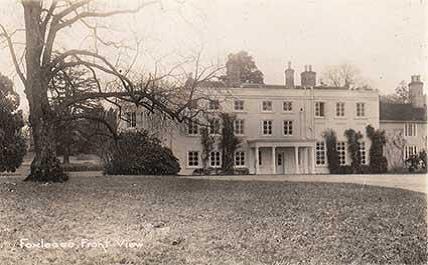
Early Photograph of Foxlease estate in Lyndhurst, purchased by Henry
in 1828.
2nd Letter
Siborne Letters No. 109. Waterloo
Foxlease, Lyndhurst, April 21st 1835.
I shall now quote my journal in answer to your first question,
because having been written when the thing was strong in my
recollection, will probably have more weight with you.
“Between five and six the emperor was so much pressed by the
Prussian advance on his right that he determined to make a last
grand effort, as he had tried every other Corps without effect,
there only remained to him the ‘Garde Imperale.’ With these he
resolved to play his last stake and to ensure success. His artillery
were ordered to concentrate their whole fire on the intended point
of attack. That point was the rise of the position about half-way
between Hougoumont, and La Haye Sainte.
“The Duke of wellington had but a short time previous rode
down to see what was doing at Hougoumont, and in returning had
ordered the 1st Brigade of Guards to take ground to it’s left and
form line four deep, which poor Frank D’Oyley did by wheeling up
the sides of the square, putting the Grenadiers and my Company (1st
Battalion Company) in the centre of the line. What would Dundas have
said !!!
“This brought the Brigade precisely on the spot the Emperor had
chosen for his attack. There ran along this part of the position a
cart road, on one side of which was a ditch and bank, in and under
which the Brigade sheltered themselves during the cannonade, which
might have lasted three-quarters of an hour. Without the protection
of this bank every creature must have perished.
“The Emperor probably calculated on this affect, for suddenly the
firing ceased, and as the smoke cleared away a most superb sight
opened on us. A close Column of Grenadiers (about seventies in
front) of la Moyenne Garde, about 6,000 strong, led, as we have
since heard, by Marshal Ney, were seen ascending the rise au pas
de charge shouting ‘Vive l’Emperor.’ They continued to
advance till within fifty or sixty paces of our front, when the
Brigade were ordered to stand up. Whether it was from the sudden and
unexpected appearance of a Corps so near them, which must of seemed
as starting out of the ground, or the tremendously heavy fire we
threw into them. La Garde, who had never before failed in an
attack suddenly stopped.(3)
Those who from a distance and
more on the flank could see the affair, tell us that the effect of
our fire seemed to force the head of the Column bodily back.
“ In less than a minute above 300 were down. They now wavered, and
several of the rear divisions began to draw out as if to deploy,
whilst some of the men in their rear beginning to fire over the
heads of those in front was so evident a proof of their confusion,
that Lord Saltoun (who had joined the Brigade, having had the whole
of his Light Infantry Battalion dispersed at Hougoumont) holloaed
out, ‘Now’s the time my boys.’ Immediately the Brigade sprang
forward. La Garde turned and gave us little opportunity of trying
the steel. We charged down the hill till we had passed the end of
the orchard of Hougoumont, when our right flank became exposed to
another heavy Column (as we afterwards understood of the Chasseurs
of the Garde)
(4)
who were advancing in support of the former Column. This
circumstance, besides that our charge was isolated, obliged the
Brigade to retire towards their original position.
“ Opportunely, Sir F. Adam’s Light Brigade had in the meantime come
round the knoll between the position and Hougoumont, when we had
been ordered to take ground to our left, and were advancing under
the hedge and blind line along the northern side of the orchard at
Hougoumont. As soon therefore as we had uncovered their front we
halted and fronted.
“ The two Brigades now returned to the charge which the Chasseurs
did not wait for, and we continued our forward movement till we got
to the bottom of the valley between the positions. Here our Brigade
halted to restore it’s order by calling out the covering Sergeants
and forming Companies. As soon as the Column was formed we proceeded
towards the chaussee (to Namur),
(5)
where we found nearly sixty pieces of Artillery jammed together and
deserted. Whilst we were halted in the valley the Light troops and
Cavalry had passed us and gone in pursuit”
I have, &c,
H. Weyland Powell.
3rd Letter
Addressed to Sir Henry Martin Baronet,
26 Upper Harley Street, Cavendish Square, London.
Waudor/or Vaudor close to Binch 20th June 1815
(6)
I wrote you a few hasty lines from our bivouac, after the battle of
Mount St Jean, or as it will probably be called Waterleud; and I
will now endeavor to give you a slight sketch of our proceedings,
since we left Engeen (7)
On the 15th------ on the evening of the
15th we heard that the French------ ------ the frontiers, and our
received orders to hold ourselves ready for marching and at 2
o’clock in the ------ we got our orders and were off at 3--- we
marched to Braine le Comte and proceeded to bivouac near Nivelle,
and whilst we were settling ourselves, came an order to move to the
left, thro’ Nivelle, and having-----it, we heard the firing very
close, and soon met a number of wounded Belgians coming in-----at 5
o’clock Gen Maitland galloped up, and ordered Simpson with the
Grenadiers (my company) to drive the French out of a wood and in
about ½ an hour we perfectly ? cleared it, and when we----at the end
of the wood, they threw in a most thunderous fire or round and grape
shot, from which we found it-----to retire, we got out of the wood,
in another part and the enemy immediately advanced columns to attack
us which deployed? Very regularly? And drove us a short way back;
however we advanced again, and they gave way; having retired to
their guns, they again advanced upon us, and having driven us back a
second time, their cavalry attempted to charge us, but a square of
black Brunswickers brought them up, while we very nimbly slipped
into the wood, on our right; and having lined? The ditch, paid them
handsomely; our loss was however very severe, and we found great
difficulty in forming our line again; but at last they effected it
with the 3rd Battalion, and everything was driven before them, and
we maintained the wood the whole night.-----The Prussians? and the
French had been engaged from two in the morning in the position of
Fleurus, and the former had been driven back; the French then tried
to get----- of the road to Brussels: they had had a severe contest
with the Dutch, and one of our Divisions, and had succeeded in
driving the Dutch out of the wood (Bossee or halogen// I think it is
called) we arrived at the very moment their skirmishers were
appearing when we dashed in, and cut them up properly: our loss this
time was very severe, out of 84, I had only 43 left in my compa’----
at night the remains of the battalion, bivouacked at the head of the
road, during which a large force arrived to our assistance; they
call this the action of the Quatre Bras.---- In the morning of
the 17th the enemy made no further attempt against us, and as the
Prussians had retired during the night, we did the same, very
leisurely, about 11 o’clock; and took up a position in front of a
village, called Waterloo, at a point where the ----, or high road to
Brussels crosses that from Nivelle to namur; here we remained quiet
through the night, except that it rained more furiously there I ever
experienced in Spain; we were quite wet thro’, and literally up to
the ancles in mud----The cavalry were engaged the 17th and the
Hussars could not make much impression upon their heavy armed
apparently; and poor Elphinstone was wounded, and taken prisoner but
escaped; the Life Guards behaved most nobly, and carried everything
before them.------ On the morn’ of the 18th June we were all in the
expectation of something being done, but first I must give you some
idea of our position, it ran from Brussels road or chau…?, to the
right, about a mile and ½ in length; and then turned to the right,
very sharply, and crossed the Chaussee? to Namur which…. Chaussee,
crosses each other; so that we were nearly in a quarter circle; at
the turn, and at the bottom of a slope, was a farm and orchard,
called Mont St Jean; this was the key of our position, and in
front of our centre. On this front the most serious attacks were
made-----At 12o’clock the column of the enemy moved down from the
heights they had occupied the night before, and our Artillery, which
had been placed all along our front, began to cannonade them most
furiously, which their artillery returned, and it was calculated
that 300 pieces were in use that day-----The infantry were drawn up
in columns, under the ridge of the position we were at
the……(or…./with two Battalions of Brunswickers, the 3rd Reg’ was in
columns in front of the turn?; and the Coldstream at the farm house;
the light infantry of the division were to defend the orchard, and
small small wood close to it: the 3rd Division to the left of our
squares; were also in squares; under cover of the ridge:
unfortunately for us, during the cannonade the shot and shells which
went over the artillery, fell into our squares, and I assure you I
never was in a more awful situation: Col Cooke my captain (and
commander of the Battalion was struck with a grape shot, as he sat
on the ground next to me-----------The Enemy now made an attack of
infantry and Cavalry, on the left, in hopes of carrying the Chaussee
to Brusselles, but the guns cut them to pieces, every time they
advanced; they then attempted to charge the Gun with Cavalry, but
the squares kept up so…….a fire, they never could reach our Guns,
tho’ the Artillery men were obliged to leave them: when the enemy
found the attempt fail on this point, he ordered an attack on the
Farm House, which was necessary for him to possess?, in order
to……the right of our position; here it was that the serious struggle
took place; two companies of the Light Infantry under Lord Saltoun,
disputed the wood, and orchard, most gallantly, but were at last
obliged to retire under the House; when the enemy were charged by
the Light infantry of the 2nd Brigade, (the Coldstream and 3rd) and
driven back with great loss; at this period the Coldstream entered
the House, which the enemy set fire to, by shells but did not
entirely consume it, and the enemy were foiled in two successive
attempts; and were each time, severely cut up by the
Artillery-----When the enemy failed in their attack on our squares,
our Cavalry rushed out from between them, and cut them up more
completely; when he found those effects vain, he began his attack
upon the centre, where we were posted; he first endeavoured to carry
the Guns with his Cavalry, which came up most gallantly, but the
squares sent them to the right about, three times in great stile, I
never saw anything so fine------The Cavalry, as before, rushing out,
and picking up the deserted cannon: after their failures, he brought
up his Garde Imperiale, just opposite our Brigade, which had formed
line, on their advancing; we were all lying under shelter of a small
bank, as they covered their advance with a moist? Terrible fire of
grape, and musketry, Bonaparte led them himself to the rise of the
hill, and told them “that was the way to Brusselles”, we allowed
them to come within about a hundred yards, when we opened so
destructive a fire, that they were soon about three hundred of them
on the ground, and they began to waver; we immediately charged but
they ran as fast as possible, the Duke of Welllington observing this
crisis, brought up the 95th and 42nd, taking the enemy in the
flank?,
(8)
and leading them himself quite close up and, the column
was entirely dispersed ---- after this we were again annoyed? With
grape and musketry, which obliged us to retire: on looking we saw
Column of the Chasseurs de la Garde Imperiale, we immediately
started double quick to meet them, firing as hard as we could, all
the time, but they had had so proper a reception just before, that
they never let us come near them; when they turned the rout? Became
general, we ran on as fast as we could, and the Cavalry started
after them, we got about two miles that evening, taking ourselves 30
pieces of cannon, nothing could be more complete, or decisive.----
the Duke’s Army was reckoned at 73,000 in the field, and it is said
that our loss has been about 20,000 killed and wounded---- The
French it is reported had 135,000 and have lost 57,000 killed and
wounded, and 13,000 prisoners, and 211 pieces of artillery; we have
taken 165, and the Prussians the rest,
(9)
fortunately the Prussians arrived first? On the field, at the moment
the Enemy fled; so that they continued the pursuit.
H.W. Powell. Capt 2nd Lieutenant First Regiment Foot Guards
PS. I have given a sketch of our position (to amuse Sir Henry) on
the other side. You will see that my account relates principally to
the part taken by the Guards, as of course my observations was
chiefly confined to where I was myself situated.
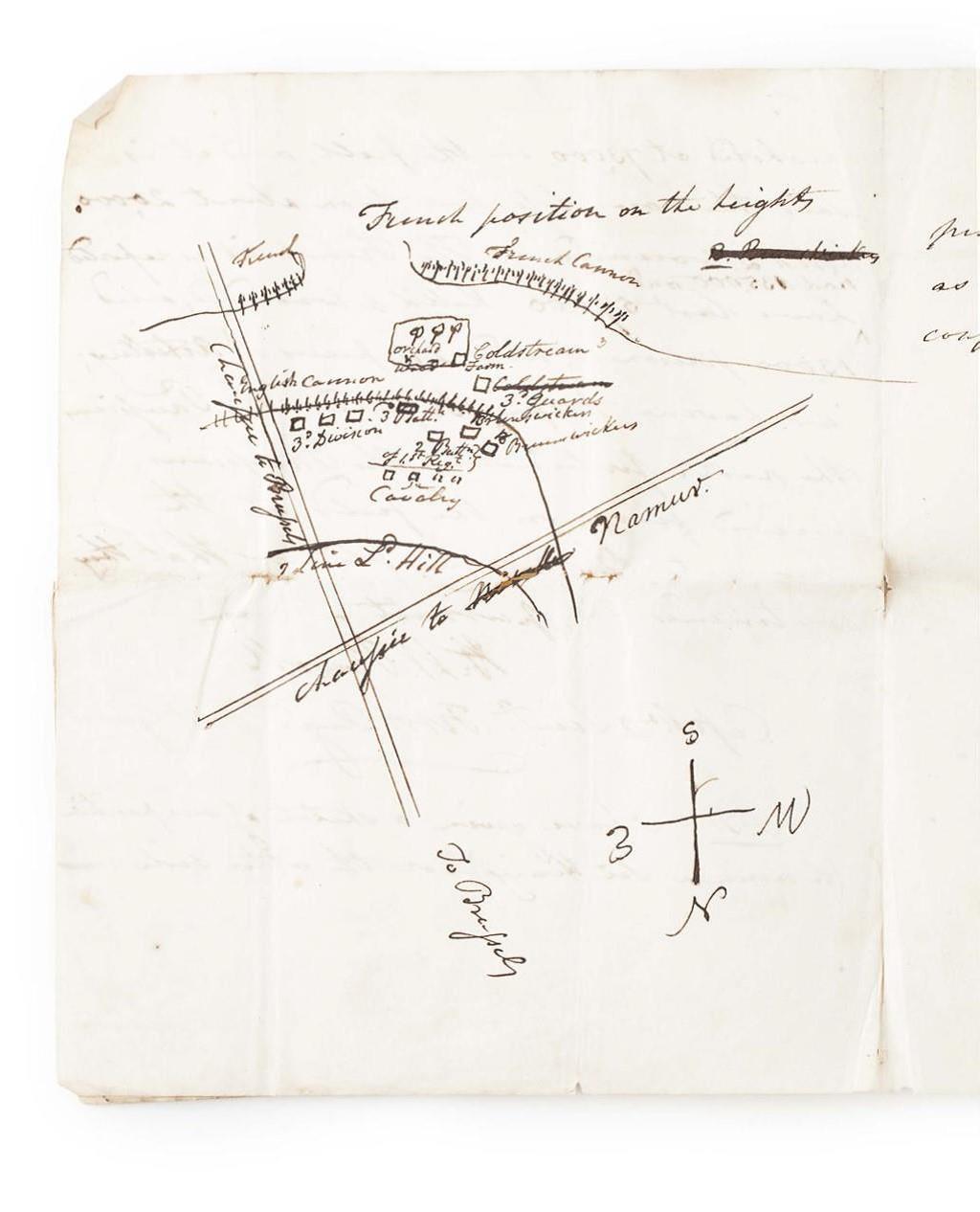
Henry Weyland Powell’s Memorial in St Michael and all Angels Church
in Lydhurst, New Forest, Hampshire. Henry was appointed High Sheriff
of Hampshire in 1834.
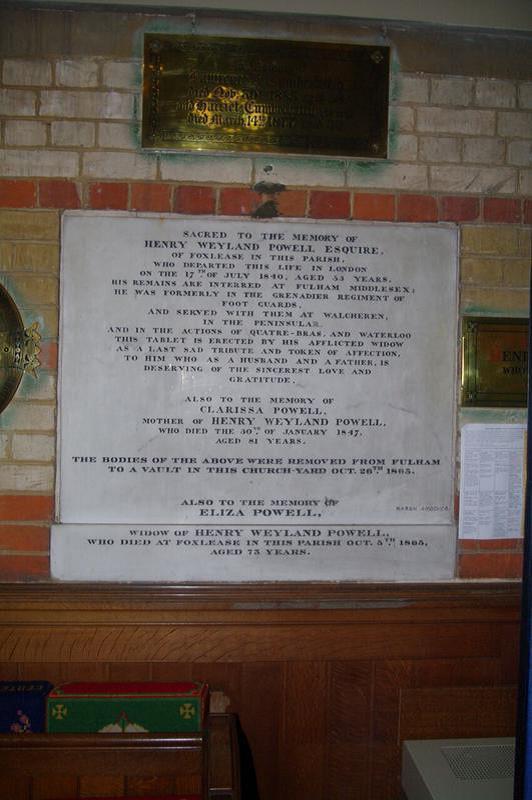
Notes :
1)
See the latest theory on the advance of the Imperial Guard in Gareth
Glover’s article. The Waterloo Journal, Vol 41, No 2 & No 3 2019.
2)
Times vary for the commencement of the action, Henry’s is one of the
earliest. It is generally accepted that the first cannon shots were
fired around 11:15 - 11:30 am.
3) There
are a few instances as one reads Henry’s letters, which remind us of
some poignant scenes depicted in Dino De Laurentiis’ block buster
film Waterloo. There can be no doubt that the research team and
editors from the film utilised some of Henry’s descriptions.
4)
According to Glover these must have been the 2nd/3rd Grenadiers,
2nd/ 1st Chasseurs and the 2nd/2nd Chasseurs. (See note 1).
5)
Henry
means the Charleroi road.
6)
Probably Waudrez, just west of Binche.
7)
Enghien,
West of Waterloo.
8) These
units were the 95th and 52nd, not the 42nd.
9) The
French entered Belgium with approx 123,000 men, their total losses
from the 15th June including killed, wounded, taken prisoner and
missing were around 46,600. The Allied Army losses, all inclusive,
were around 25,000 with those engaged at Waterloo being around
17,000 from an original strength in Belgium of about 90,200. The
Prussians lost 7,000 at Waterloo and had about 10,000 deserters on
the 17th June on their retreat from Ligny to Wavre.
Sources consulted:
Adkin, Mark. The Waterloo Companion. Arum press ltd 2001.
Siborne, H.T. The Waterloo Letters. Arms & Armour press 1983.
Glover, Gareth. The Imperial Guard at Waterloo. The Waterloo journal
Vol 41, No’s 2 & 3.
The Waterloo Medal Roll. The Naval and Military press Ltd.1992.
Dalton, Charles. The Waterloo Roll Call. Arms and Armour press 1978.
Bromley, Janet & David. Wellington’s Men Remembered. Praetorian
press, Pen & Sword books ltd. 2015.
Henry’s first Son, Henry Buckland Powell Montgomery, with
inscription to his father. Memorial plaque in St Michael and all
Angels Church, Lyndhurst.
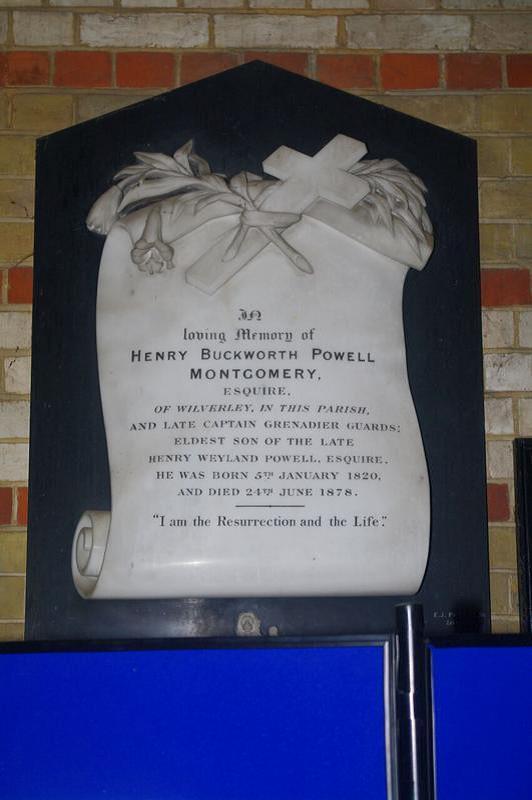
The Portsmouth Napoleonic Society
'Over The Hills and Far Away'


